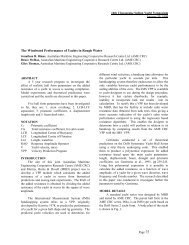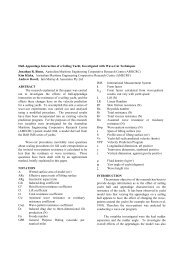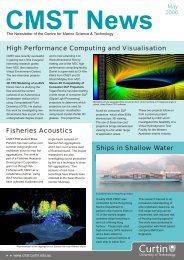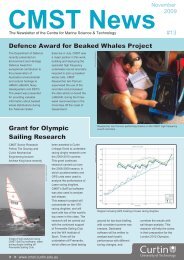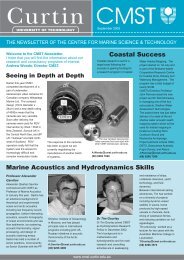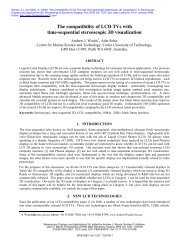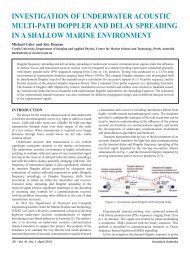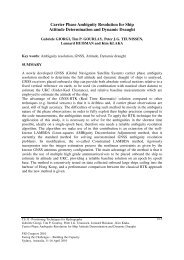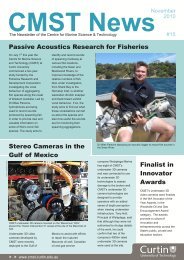Blue whale calling in the Rottnest trench-2000, Western ... - ANP
Blue whale calling in the Rottnest trench-2000, Western ... - ANP
Blue whale calling in the Rottnest trench-2000, Western ... - ANP
You also want an ePaper? Increase the reach of your titles
YUMPU automatically turns print PDFs into web optimized ePapers that Google loves.
dB for first spectral peak and 3 dB for second spectral peak) <strong>the</strong> correlation po<strong>in</strong>t was deemed<br />
correct.<br />
This gave <strong>the</strong> presence of a component. To give <strong>the</strong> number of dist<strong>in</strong>ct <strong>call<strong>in</strong>g</strong> animals with<strong>in</strong><br />
each 90 s block, <strong>the</strong> number of type II components was counted (s<strong>in</strong>ce it was not possible for a<br />
s<strong>in</strong>gle animal to produce more than one type II component <strong>in</strong> a 90 s block) and <strong>the</strong> number of<br />
type II components which fell with<strong>in</strong> 32.5 s of <strong>the</strong> block start added to this (s<strong>in</strong>ce a type III<br />
component followed around 22 s after a type II component and ran for approximately 23 s, thus a<br />
lead<strong>in</strong>g type III component <strong>in</strong>dicated a different caller). Type I components which fell <strong>in</strong> <strong>the</strong> last<br />
45 s of <strong>the</strong> block also would <strong>in</strong>dicate a different caller, but were ignored <strong>in</strong> this version of <strong>the</strong><br />
search technique as <strong>the</strong> correlation technique was not tuned for correct type I component<br />
identification.<br />
An example plot for a poor correlation, show<strong>in</strong>g <strong>the</strong> block spectrogram, result<strong>in</strong>g correlation<br />
vectors, and <strong>the</strong> component presence is shown on Figure 38. In this example <strong>the</strong> lead<strong>in</strong>g portion<br />
of <strong>the</strong> type I component has been falsely recognised as a type III component. This was only a<br />
problem for high SNR type I components. The type I recognition was not optimised and has<br />
falsely recognised a second type I component.<br />
The technique was run across 4827 records of <strong>the</strong> bluey logger and cross checked aga<strong>in</strong>st 500<br />
records which were manually counted for <strong>the</strong> number of callers. The result<strong>in</strong>g errors of <strong>the</strong><br />
number of callers manually counted m<strong>in</strong>us <strong>the</strong> number of callers automatically recognised is<br />
shown by <strong>the</strong> distribution plot of Figure 39. The correct number of callers accounted for 35% of<br />
<strong>the</strong> sample, with <strong>the</strong> majority of <strong>the</strong> rema<strong>in</strong><strong>in</strong>g blocks under-sampled. Reasons for <strong>the</strong><br />
discrepancies were:<br />
• <strong>the</strong> lead<strong>in</strong>g portion of <strong>the</strong> type I component be<strong>in</strong>g mistaken for a type II component - only an<br />
issue for <strong>the</strong> few high SNR type I components;<br />
• very low component level or SNR - <strong>the</strong> most common error but not considered important <strong>in</strong><br />
<strong>the</strong> acoustic census<strong>in</strong>g technique described below, s<strong>in</strong>ce detection was limited on received<br />
level to those calls likely to be with<strong>in</strong> <strong>the</strong> <strong>Rottnest</strong> <strong>trench</strong> region only, thus low SNR<br />
components were rejected from count<strong>in</strong>g anyway;<br />
• occasional mistake of type II for a particular sequence of close 20 Hz 'click<strong>in</strong>g' signal<br />
(section 3.5) - although this was rare and <strong>the</strong> algorithm was generally robust <strong>in</strong> reject<strong>in</strong>g <strong>the</strong><br />
click<strong>in</strong>g signals;<br />
• propagation effects caus<strong>in</strong>g pronounced variability <strong>in</strong> <strong>the</strong> received level throughout a<br />
component (ie. Figure 13) - mistakes here were worst for components with high lead<strong>in</strong>g and<br />
end sections and low middle sections;<br />
• a particular comb<strong>in</strong>ation of vessel tones be<strong>in</strong>g mistaken for a component - this was rare as it<br />
required <strong>the</strong> right mix of tones;<br />
• propagation effects caus<strong>in</strong>g variability <strong>in</strong> <strong>the</strong> received level of <strong>the</strong> different spectral<br />
components - <strong>the</strong>re were some blocks where components were rejected as <strong>the</strong> harmonics<br />
were lost due to different propagation of <strong>the</strong> different frequencies.<br />
It is believed <strong>the</strong> correlation technique can be improved considerably by several adjustments,<br />
particularly by differences <strong>in</strong> <strong>the</strong> normalisation methods and vary<strong>in</strong>g <strong>the</strong> relative <strong>in</strong>tensity of<br />
component harmonics, so that <strong>the</strong>y play a greater role <strong>in</strong> <strong>the</strong> <strong>in</strong>itial correlation.<br />
36



